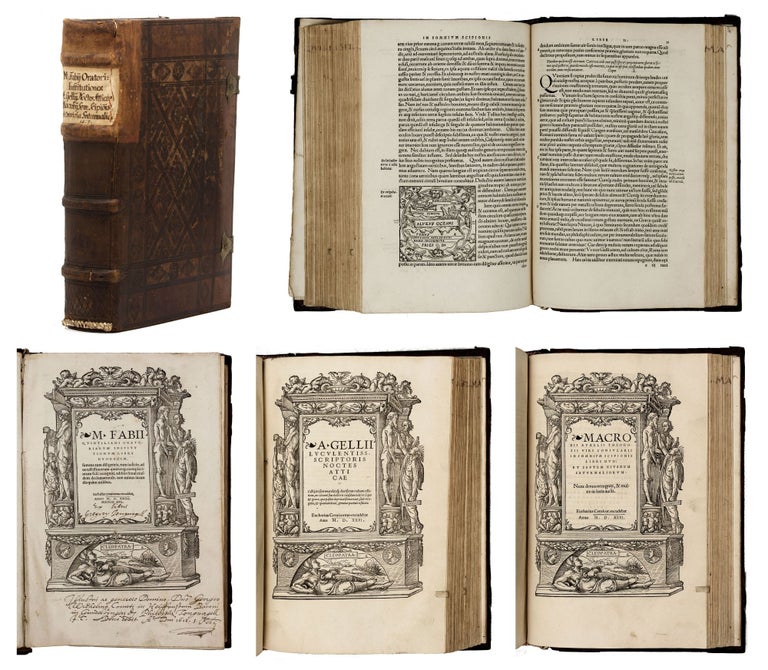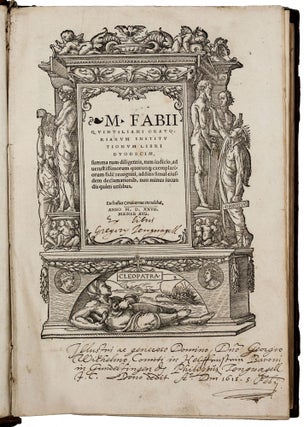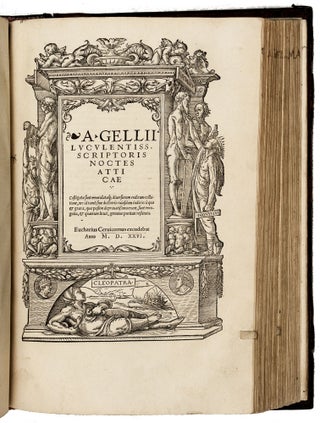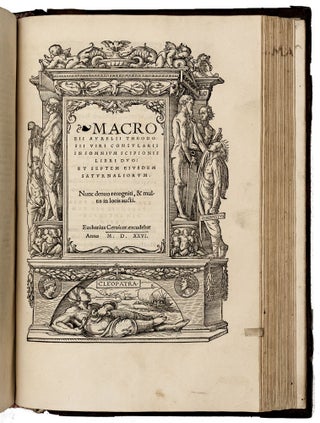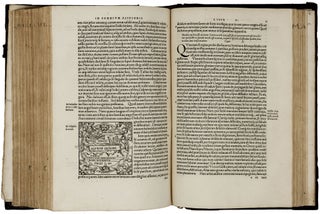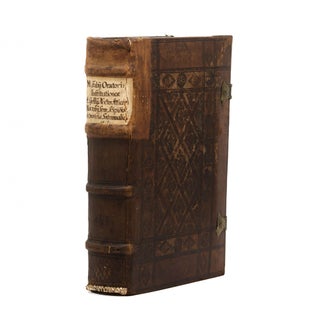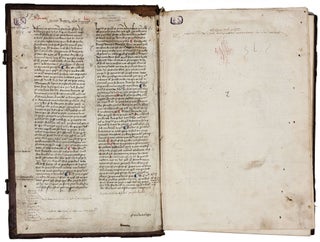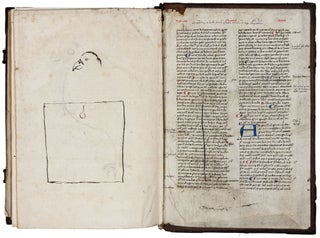Oratoriarum Institutionum Libri Duodecim.
Folio [31 x 21.5 cm], (4) ff., 330 pp., 1 blank. Elaborate woodcut title page with figures of Dionysius, Cleopatra, and others. Woodcut head- and tail-pieces and initials. Contemporary calf over boards, blind-tooled with diamonds and floral ornaments; repair to top 2 compartments of spine, metal clasps partly defective, lower hinge going, first quire pulling away from bookblock. Front and back pastedowns from a 15th-c. Latin theological manuscript. Blank portions of title page have two 17th-c. ownership inscriptions; others scattered on pastedowns and flyleaves; a few doodles/drawings on blanks at rear of volume. Early marginal notes and underlining through most of the work. A very attractive copy. [Bound with:] AULUS GELLIUS. Noctes Atticae. (Cologne), Eucharius Cervicornus [colophon: for Gottfried Hittorp], 1526. (12) ff., 202 pp., (13) ff. Same woodcut title page as the work above. Elaborate woodcut border on p. 1 incorporates figures of Agrippina and M. Agrippa, with the printer’s device at the foot. Woodcut head- and tail-pieces and initials. Very fine. [And with:] MACROBIUS. In somnium Scipionis Libri duo et Septem Eiusdem Saturnaliorum ... Nunc denuo recogniti, & multis in locis aucti. (Cologne), Eucharius Cervicornus [colophon: for Gottfried Hittorp], 1526. (10), 140 ff. Same woodcut title page as the works above. Woodcut head- and tail-pieces and initials. Three woodcut diagrams within text (9r, 24v, 26v). A few marginal notes. Very fine. These editions of Roman classics are very rare and handsomely printed and bound: first edition printed by Cervicornus of Aulus Gellius; second edition, revised and expanded, of Cervicornus’s Quintilian and Macrobius, both first published in 1521. OCLC lists no location for Quintilian, and only one copy each of Aulus Gellius and Macrobius (both at the Bayerische Staatsbibliothek). Eucharius Cervicornus (a.k.a. Hirtzhorn), active 1516-1547, was one of the few Cologne printers who produced not only general-interest publications but classical and humanist literature. Among his publications were works by Hermann von dem Busche, one of the younger, more aggressive generations of humanists, whose Vallum humanitatis (1518) argued in favor of humanist studies against scholasticism in pre-Reformation Germany. These three volumes were funded by Gottfried Hittorp (1485-1579), a member of a patrician family who was involved with publishing in his native Cologne as early as 1512, working particularly with Hirtzhorn and Johann Soter. Until the mid-1520s Hittorp concentrated on editions of classical authors, and received praise from humanists such as Melanchthon and Gerardus Bucoldianus. From about the time that these three works were published, however, Hittorp turned more and more to the publication of theological literature, in keeping with a trend in Cologne as Lutheranism became an important factor in intellectual discourse. The Institutio Oratoria was written after a lifetime of teaching by Quintilian (ca. 35-ca. 100), a Roman rhetorician whose students included Pliny the Younger and possibly Tacitus and Juvenal. The Institutio is important for several fields: it is one of the greatest surviving ancient treatises on the theory and practice of rhetoric; it cites many ancient authors and critiques them, making it an influential document in the history of literary criticism; and it is a landmark work on education, since Quintilian discusses the future orator’s education almost from birth. For much of the Middle Ages the Institutio was known only in fragments, but after a complete copy was found by Poggio Bracciolini in 1416 the work soon became enormously popular, providing the inspiration for a new, humanistic type of education. Over 40 editions appeared between 1470 and 1539. Martin Luther, whose writings show signs of Quintilian’s influence, praised Quintilian “in that he educates and at the same time demonstrates eloquence, that is, he teaches in word and in deed most happily.” Like Quintilian, Aulus Gellius (ca. 125-after 180) incorporated excerpts from many ancient authors whose works have since been lost. The Noctes Atticae is a compendium of notes ranging from grammar and geometry to philosophy and history: earthquakes, colors, the nature of the voice, why dolphins love boys, Euripides, hellebore, sailing terms, Alexander the Great’s horse. The editio princeps appeared in Rome, 1469, and by the late 16th c. Aulus’s influence could be seen in both Montaigne and More. Ambrosius Theodosius Macrobius (fl. 395-423), grammarian and Neoplatonist, left a commentary on Cicero’s Dream of Scipio (excerpted from his Republic) that describes the Stoic view of life after death and the organization of the universe. It includes sections on astronomical beliefs during the late Roman Empire that were still current when this volume was printed, here illustrated with diagrams illustrating the earth as the center of the universe (f. 24v) and why the earth does not move (f. 26v). The commentary was also esteemed in the Middle Ages for its analysis of dreams. The Saturnalia, like the Noctes Atticae, is valued for incorporating fragments of ancient authors since lost, and (again like the Noctes) includes essays on a wide array of topics, e.g.: luxury and sumptuary laws, the power of wine, the movement of celestial bodies, the source of the best eels, Pythagoras, and the insensitivity of human teeth. The editio princeps of Macrobius appeared in Venice, 1472. *Quintilian: Hollis BGK 5722; not in Adams. OCLC lists without location. Aulus Gellius: Hollis BBL 3929 [1526] identical collation; cf. Shaaber G-88; not in Adams. OCLC lists no copy in the U.S. Macrobius: Hollis BDL 9355; Shaaber M-16; not in Adams. OCLC lists no copy in the U.S.
Price: $4,850.00

